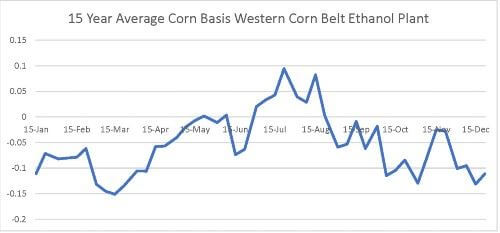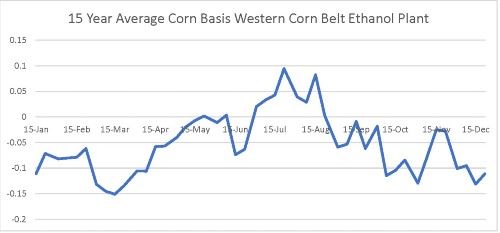Basis History
May 18, 2020

Kevin Schweer, Grain Merchandiser/ Marketing Advisor
Basis is calculated by subtracting the nearby futures price from the cash price. Basis captures the effects of local supply and demand, storage costs, as well as transportation costs. During times of abundant supply(harvest)or when demand is weak, basis values tends to be low. Conversely, light selling, (often during spring planting or in low futures markets) or strong demand will tend to strengthen basis.
Looking at the chart below, we can see that over the last 15 years the average basis peak was in July. No surprise that during planting season basis was also notably strong. We may have seen basis peak during July since this is usually a time of strong demand while buyers are trying to get covered for their old crop demand until new crop arrives. Ethanol plants typically are running full throttle in the summer since this is typically when they have their best margins while we are in peak “driving season”. During years of tighter local supplies or if supply for new crop are expected to be low, farmers may have space to carry a portion of their old crop or to wait for higher prices. Both tight local supplies and a poor incoming crop last year (2019) led to the highest basis since 2012.
Just as basis can reach its peak in the summer, other years it can also make new lows. In years where supplies are sufficient (2016), and a normal/large crop is on the way, elevators and farmers sell any remaining old crop to make storage space for new crop which depresses basis values during the summer months.
When it comes to help finding the best market for your operation, our Grain Marketing Advisors are second to none. Marketing options through CFS are endless as we sell to rail, river, ethanol, feed mills and local livestock producers.

Basis is calculated by subtracting the nearby futures price from the cash price. Basis captures the effects of local supply and demand, storage costs, as well as transportation costs. During times of abundant supply(harvest)or when demand is weak, basis values tends to be low. Conversely, light selling, (often during spring planting or in low futures markets) or strong demand will tend to strengthen basis.
Looking at the chart below, we can see that over the last 15 years the average basis peak was in July. No surprise that during planting season basis was also notably strong. We may have seen basis peak during July since this is usually a time of strong demand while buyers are trying to get covered for their old crop demand until new crop arrives. Ethanol plants typically are running full throttle in the summer since this is typically when they have their best margins while we are in peak “driving season”. During years of tighter local supplies or if supply for new crop are expected to be low, farmers may have space to carry a portion of their old crop or to wait for higher prices. Both tight local supplies and a poor incoming crop last year (2019) led to the highest basis since 2012.
Just as basis can reach its peak in the summer, other years it can also make new lows. In years where supplies are sufficient (2016), and a normal/large crop is on the way, elevators and farmers sell any remaining old crop to make storage space for new crop which depresses basis values during the summer months.
When it comes to help finding the best market for your operation, our Grain Marketing Advisors are second to none. Marketing options through CFS are endless as we sell to rail, river, ethanol, feed mills and local livestock producers.

